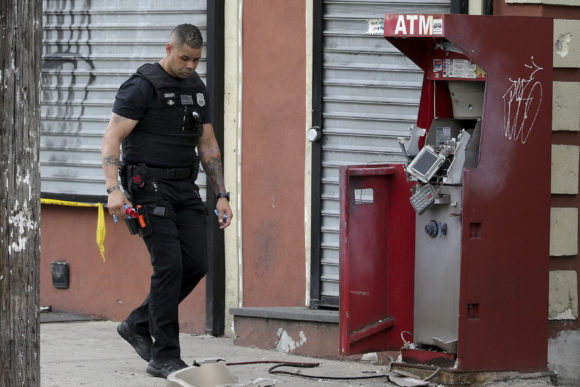Convicted bank robber Willie Sutton, when asked why he robbed banks, famously said, “because that’s where the money is.”
In today’s socially distanced world, criminals increasingly are turning their attention to the money inside automated teller machines — whether outside a bank or inside a neighborhood convenience store. And their smash-and-grab method of extraction — often involving heavy equipment stolen from nearby construction sites — has become yet another COVID-19 cost driver for insurance carriers.
Travelers says that claims for damages because of ATM thefts increased by 220% from 2019 to 2020. Due to COVID-19 bank closures or restricted hours, customers are encouraged to use ATMs and banks are holding more money in them than before.

“You might not hear too many instances of someone just walking into a bank and robbing it,” said Tracey Santor, bond product manager for Travelers. “People might be relying more on ATMs. That’s where the money is going.”
Santor said claims for cash stolen from smashed ATMs are often accompanied by significant property damages. The ATMs themselves can cost $30,000 to $80,000, she said. They may be stuffed with $40,000 in cash.
“I’ve seen front-end loaders or big equipment take out the entire wall,” she said. “I’ve read stories about liquor stores, in the middle of the day they ran their truck into it and they are like a pit crew in a NASCAR race.”
The Texas Bankers Association noted the uptick in ATM crimes and appointed an ATM Crime Task Force last fall to focus public attention to the problem. A TBA report says that Houston and Southeast Texas have long been a hotbed of ATM crimes, but last summer and fall its member banks reported even more numerous “smash and grab” attacks on the money machines. Criminals were using construction vehicles or heavy-duty trucks to rip apart ATM encasements to get access to cash.
The association said the FBI also alerted it to a growing problem when it issued a Private Sector Liaison report in October that said criminals were using explosives to breach ATMs. Also that month, an insurance carrier told the association’s Bankers Insurance Agency “that they were experiencing losses at such a rate that it could soon impact bank policy deductibles and premiums.”
The task force said in a November report that organized crime is the predominant source of ATM crimes in Texas, with about 95% of those groups based in the Houston area. FBI officials taking part in the task force meeting said that they have made more than 50 arrests and are actively tracking about 250 suspects believed to be involved in the crime rings.
Law enforcement sources told the task force that Texas banks have lost about $13 million from ATM thefts, but that’s only half the problem.
“When the cost of equipment damage is combined with cash losses, the total estimated ATM smash and grab losses in Texas skyrocket to $24 million,” the report says.
Civil unrest after the Minneapolis police killing of George Floyd created a diversion that emboldened the ATM crime rings. A report by the Wall Street Journal, citing information from ATM supplier Cardtronics, said criminals attempted to breach 240 ATMs in 17 cities between late May and the end of June. About half of those were in Chicago and Philadelphia.
The Journal, citing Philadelphia police, reported that 157 ATMS in the city were damaged or destroyed with explosives in 2020 — compared to five in 2019 and two in 2018. The head of the police department’s bomb disposal unit told the newspaper that most of the explosions occurred during civil unrest. Hundreds of other machines were damaged by mechanical means, the Journal reported.
Security device manufacturer 3SI, citing data from the ATM Industry Association, said the number of ATM crimes increased 148% from 2019 to 2020. Theft of the whole ATM using a vehicle increased by 53% and the use of explosives in safe breaking attacks increased by 23%.
Texas had the most ATM crimes by far, nearly doubling the number in more populous California, which ranked second. The average amount stolen was $83,000, 3SI said.
The increase in crime led to the release of a new product. On Wednesday, 3SI announced that the launch of the ATM Cassette Tracker, a device that augments the ATM Tracker product that tracks the location of stolen machines.
Lisa Moughan, marketing and communications manager for the Malvern, Pa.-based company, said each the tracking devices sends a signal directly to 911 dispatchers whenever motion is detected. She said the dispatchers can track the exact locations of stolen machines or cassettes as the criminals make their escape. She said the system protects responding police officers because they can hold off on moving in until the criminals reach a location that appears the most safe. That avoids high-speed chases that endanger police and bystanders both.
Moughan said 95% of the money stolen from ATMs that are equipped with 3SI trackers is recovered by police. She said often the criminals have to leave the money behind because police start responding before they’ve opened up the machines.
Moughan said 3SI added the cassette tracker to its product offerings because criminals have upgraded their techniques. Instead of stealing entire machines, they use a hook and chain attached to a truck or tractor to yank the door off the machine and make off with the cassettes inside that hold the cash.
“They get more sophisticated all the time,” she said.
About the photo: A member of the Philadelphia bomb squad surveys the scene after an ATM machine was blown-up at 2207 N. 2nd Street in Philadelphia, Tuesday, June 2, 2020. (David Maialetti/The Philadelphia Inquirer via AP)
Was this article valuable?
Here are more articles you may enjoy.


 Palantir Poaching Suit Called ‘Scare’ Tactic by Ex-Employees
Palantir Poaching Suit Called ‘Scare’ Tactic by Ex-Employees  First Brands Judge Approves Examiner to Probe Fraud Allegations
First Brands Judge Approves Examiner to Probe Fraud Allegations  Musk’s xAI Faces California AG Probe Over Grok Sexual Images
Musk’s xAI Faces California AG Probe Over Grok Sexual Images  California Bill Would Require Insurer Claims Handling Plans, And Double Penalties
California Bill Would Require Insurer Claims Handling Plans, And Double Penalties 